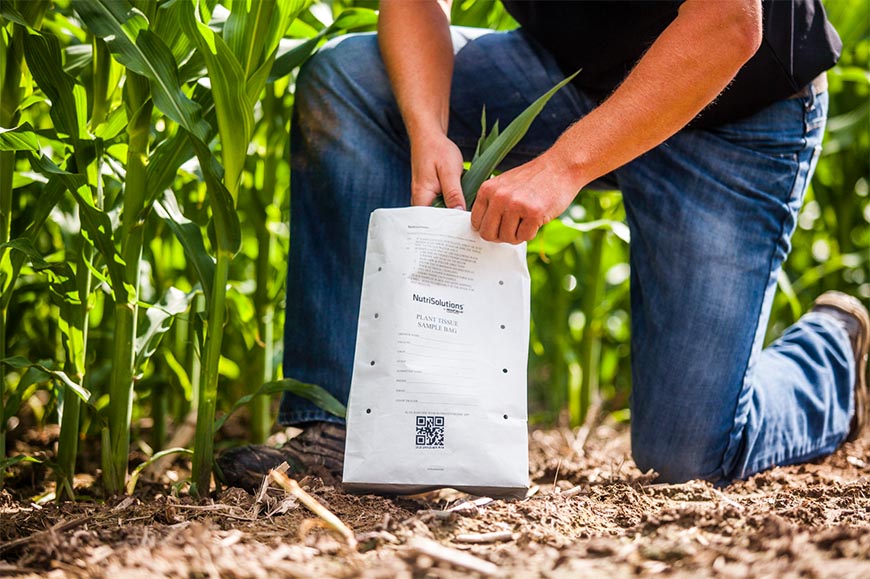4 Ways to Leverage Tissue Sampling Insights in the Off-Season

The majority of farmers who choose to take tissue samples are looking for in-season insights to help them fine-tune their fertilization programs. But tissue nutrient analysis can also tell you a lot about your production practices and identify changes that can be made to improve productivity. Here are four ways you can use tissue sampling results in the off-season to make changes to your management practices.
1. Soil and tissue analysis comparison can reveal potential problems. When used together, soil and tissue testing can help you identify potential issues in your field. For example, if soil analysis reveals you have ample nutrients present but tissue testing shows that they aren’t being taken up by the plant, that’s an indication that there may be issues with root growth caused by compaction, environmental conditions or shallow planting.
2. Tissue sampling helps calibrate the Field Forecasting Tool. The R7® Field Forecasting Tool (FFT) delivers more accurate results as new information is added to the model. The tissue sampling results from the NutriSolutions® app can be automatically fed into the FFT and can help estimate yield potential in-season. The model can also be used in the off-season to help establish management practices for the future that can reduce the gap between the forecasted yield and the actual yield.
3. Evaluating nitrogen trends can help with seed selection. If you find your plant nitrogen levels are often trending low, you might choose to be more aggressive with your nitrogen applications. But if you’re looking to maintain input costs, an alternative would be to place a hybrid that has a low response-to-nitrogen score on those acres in the future, knowing that nitrogen could be limiting.
In 2017, we tested 210 hybrids at our Answer Plot® locations and found 36 percent were highly responsive to nitrogen, 45 percent were moderately responsive and 19 percent were less responsive to nitrogen. Across the tested hybrids, there was a 39.5- to 97.2-bushel-per-acre yield response gradient, illustrating the vast differences genetics can have on nitrogen utilization in plants.
4. Choose the right seed if zinc comes up short. If tissue sampling trends reveal an early-season zinc shortage, consider using CROPLAN® corn hybrids on your acres. All CROPLAN hybrids are treated with Advanced Coating® Zn seed treatment. By coating seeds with zinc, Advanced Coating Zn promotes quick emergence, even in cool, wet conditions, and it helps establish strong, healthy stands. In nearly 180 Answer Plot program test plots over three years, corn treated with Advanced Coating Zn seed treatment averaged an extra 2 bushels per acre.
Don’t put your tissue sampling results on the shelf once you’ve used them to make in-season decisions. Evaluating nutrient data in the off-season can help you develop a more comprehensive crop management plan that includes mapping out management zones and choosing the right hybrids and seed treatments based on what nutrient trends are showing. Work with your WinField United retailer to put your tissue sampling results to work in the off-season.
Advanced Coating®, Answer Plot®, CROPLAN®, NutriSolutions®, R7® and WinField® are trademarks of WinField United.
1. Soil and tissue analysis comparison can reveal potential problems. When used together, soil and tissue testing can help you identify potential issues in your field. For example, if soil analysis reveals you have ample nutrients present but tissue testing shows that they aren’t being taken up by the plant, that’s an indication that there may be issues with root growth caused by compaction, environmental conditions or shallow planting.
2. Tissue sampling helps calibrate the Field Forecasting Tool. The R7® Field Forecasting Tool (FFT) delivers more accurate results as new information is added to the model. The tissue sampling results from the NutriSolutions® app can be automatically fed into the FFT and can help estimate yield potential in-season. The model can also be used in the off-season to help establish management practices for the future that can reduce the gap between the forecasted yield and the actual yield.
3. Evaluating nitrogen trends can help with seed selection. If you find your plant nitrogen levels are often trending low, you might choose to be more aggressive with your nitrogen applications. But if you’re looking to maintain input costs, an alternative would be to place a hybrid that has a low response-to-nitrogen score on those acres in the future, knowing that nitrogen could be limiting.
In 2017, we tested 210 hybrids at our Answer Plot® locations and found 36 percent were highly responsive to nitrogen, 45 percent were moderately responsive and 19 percent were less responsive to nitrogen. Across the tested hybrids, there was a 39.5- to 97.2-bushel-per-acre yield response gradient, illustrating the vast differences genetics can have on nitrogen utilization in plants.
4. Choose the right seed if zinc comes up short. If tissue sampling trends reveal an early-season zinc shortage, consider using CROPLAN® corn hybrids on your acres. All CROPLAN hybrids are treated with Advanced Coating® Zn seed treatment. By coating seeds with zinc, Advanced Coating Zn promotes quick emergence, even in cool, wet conditions, and it helps establish strong, healthy stands. In nearly 180 Answer Plot program test plots over three years, corn treated with Advanced Coating Zn seed treatment averaged an extra 2 bushels per acre.
Don’t put your tissue sampling results on the shelf once you’ve used them to make in-season decisions. Evaluating nutrient data in the off-season can help you develop a more comprehensive crop management plan that includes mapping out management zones and choosing the right hybrids and seed treatments based on what nutrient trends are showing. Work with your WinField United retailer to put your tissue sampling results to work in the off-season.
Advanced Coating®, Answer Plot®, CROPLAN®, NutriSolutions®, R7® and WinField® are trademarks of WinField United.





